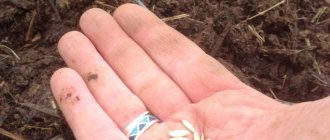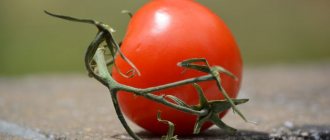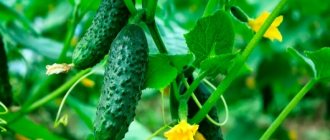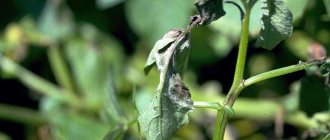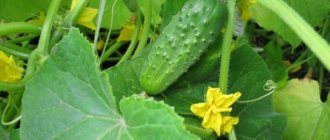Description and characteristics of cucumber April F1
Cucumber April F1 is a first generation hybrid. This means that it is obtained from crossing two varieties and combines the best qualities of the parent lines. Therefore, the April cucumber is resistant to adverse weather conditions and is highly productive.
The April cucumber F1 is parthenocarpic and produces mainly female flowers, which makes it possible to grow the crop in greenhouses and indoor conditions. Also suitable for growing in open ground, in film tunnels. Gives an early and friendly harvest. Shows long fruiting. It has early ripening periods - 40-45 days from emergence. The purpose of the fruit is universal.
An important feature of the April cucumber variety is that the plant has weak branching and produces few side shoots, which does not require pinching and pinching. Can be grown without a garter. The main stem is long, the leaves are large.
Detailed description of the variety
The main advantage of this variety is that it does not need insects for pollination. This allows you to successfully grow April cucumber in a greenhouse, as well as on a windowsill or even on a balcony. These cucumbers were bred in 1977 and since then have been one of the most popular and versatile varieties. This is a first-generation hybrid, which has a central lash length of about 2 m. At the same time, the side lashes do not grow. Most of the flowers on the plant are female.
Taste qualities of cucumbers
The characteristics and description of the April cucumber variety indicate that it is genetically devoid of bitterness. Received high praise for its taste at an international exhibition. When growing, it is important to remove the fruits in time so that they do not overgrow, which makes their skin thicker. The length of the ripe fruit is 15-25 cm, weight is 200-250 g. The shape is elongated, cylindrical, the surface is coarsely tuberous. The skin is tender. The fruits are well suited for fresh consumption, canning and pickling.
Possible problems and recommendations
Sometimes when growing cucumbers you may encounter the following problems:
- Fall of the ovary. The fruits, before they have time to grow, turn yellow and crumble, which may be due to low air temperatures, very high humidity or lack of fertilizing. Adjust these indicators and everything will work out.
- Yellowing and drying of leaves during plant growth. The problem is due to a lack of nitrogen, which can be corrected by fertilizing with any nitrogen-containing fertilizer.
- Wilting of fruits and shoots of the plant. This may be a sign of damage to the root system of the plant, which can no longer be cured - the plant will die.
- Lack of ovary on many flowers. The reason is extreme heat, excess nitrogen. Adjust your fertilizing schedule to avoid this problem.
Pros and cons of the April cucumber variety
April cucumbers are one of the earliest ripening and hardiest varieties. You can get a decent harvest even just on the balcony. The hybrid is also widely zoned; it can be grown in open ground throughout Russia, except for the northern regions.
Other advantages of the variety:
- insects are not required for pollination;
- friendly return of the harvest;
- long fruiting;
- ease of care;
- resistance to some cucumber diseases;
- does not turn yellow.
The disadvantages of April cucumbers include the fact that the hybrid cannot be re-sown with its own seeds. And also the fact that the fruits quickly ripen on the vine.
Diseases and pests
With proper agricultural technology, April bushes rarely get sick. The variety has low resistance to infection (sclerotia fungus), which causes white rot. The reasons for its occurrence:
- high soil moisture;
- a sharp drop in temperature;
- thickened planting (open ground);
- lack of ventilation (closed ground).
The fungus damages the roots, stems, and leaves of plants. The harvest suffers from it. Fruits that appear healthy on the outside quickly spoil. They cannot be used for food. Scheme for combating white rot:
- do not water the ridge for a while;
- cut out the lashes affected by the fungus, capturing part of the healthy tissue, sprinkle the wound with crushed coal;
- treat the bushes with an antiseptic (Oxyx, Topaz);
- ventilate the greenhouse.
During the period of active fruiting, those who do not accept chemistry prepare a folk remedy. Take 3 parts whey, 7 parts water. Add 1 teaspoon of copper sulfate to 10 liters of solution.
Pests rarely attack April cucumber bushes. To prevent them, the usual measures are sufficient: observe crop rotation, keep the soil clean, and renew the top layer of soil in the greenhouse every 2 years.
Growing April F1 cucumbers
The April cucumber is a heat-loving crop that develops only at temperatures above +15°C. Cucumbers also need constant moisture and feeding. Cucumbers love to grow in high, warm ridges due to the structural features of the root system. Favorable predecessors for them are tomatoes, cabbage, and onions.
Planting seedlings
April cucumbers should remain in the seedling phase for no more than 30 days, not taking into account the first week for the emergence of seedlings. They can be planted in a permanent place with 1-3 true leaves. You should not overexpose the seedlings, because the root system will not have enough nutrition in a cramped container and the plant will begin to hurt.
Cucumbers do not tolerate picking well, so for seedlings you need to choose a planting container from which it will be convenient to remove the earthen ball later. To do this, the container is rolled up from a thick bag, plastic cups with the bottom cut off are taken, or cucumbers are sown in peat tablets.
Advice! For coated cucumber seeds, no pre-sowing preparation is carried out and they are sown dry.
The soil for growing seedlings is made loose and airy. To do this, add coconut substrate, rotted sawdust or river sand to purchased or garden soil.
Example of soil mixture:
- 10 kg of any soil;
- 2-3 kg of vermicompost;
- 3 kg coconut substrate.
To revitalize the soil, beneficial bacteria in liquid or dry form are added to it 2-3 weeks before planting. The components are thoroughly mixed and poured into a black bag and stored closed.
Add the prepared substrate halfway to the planting container, lightly compact it, and water with warm water. After this, the seeds are laid out on the surface and covered with 1-2 cm of dry soil. After this there is no need to water.
Seeds germinate at a temperature of +22… +25°C. Germination will take 4-7 days. At this time, the crops should be kept under film in a warm place. You can place containers with seedlings on heated floors, but not on heating appliances.
As soon as the seedlings appear, the planting containers are placed in a bright place. Plants should receive about 12 hours of light. At night, plants should be at rest in the dark.
When grown on balconies, seedlings are transplanted into containers with a volume of 5 liters or more with drainage holes.
Landing in the ground
Cucumbers of the April f1 variety should be grown at a distance of 0.5 m from each other, and the rows should be 1.5 m apart. The plants are arranged in a checkerboard pattern. This distance allows the bushes to be well ventilated and not shade each other; the plants are less susceptible to fungal diseases.
By direct sowing into the ground, April cucumbers are planted in loose and heated soil.
Important! The soil crust prevents seed germination.
In the soil, the seeds can be damaged or eaten by pests, so they are surrounded with a plastic ring when planting. And seedlings can be planted directly with a plastic cup, if its bottom has been previously cut off.
Cucumber roots need warmth. It is beneficial to grow them in beds, which are made according to the principle of a layer cake with a mixture of soil and organic matter or a compost heap. Organic matter in such a ridge releases heat as it decomposes. You can plant seedlings in it earlier. Also, a warm bed releases nitrogen, which is necessary when growing crops.
To transplant seedlings, make a large hole into which a quarter of humus and 1 tbsp are poured. l. ash, sprinkle with water. The seedling is dipped into the earthen slurry and covered with dry soil. After planting, about 3-4 liters of water are poured under the bush. In open ground in hot weather, plantings need to be shaded for a while.
Watering and fertilizing
Cucumbers are a demanding crop when it comes to watering and air humidity. Therefore, they are watered once every 3 days, and during fruiting - once every 2 days. The peculiarity of watering is that it is important to carry it out over the entire planting area, and not just at the root. In hot weather, the row spacing is also watered, because the cucumber root system spreads widely and in open ground can extend beyond the ridge. Water the cucumbers in the evening with warm water.
The root system of cucumbers is superficial and gets washed away very quickly when watered. Therefore, it is best to cover the soil under cucumbers with mulch from mown grass.
Advice! Mulch is added continuously throughout the growing season.
Under the mulch in a moist and breathable environment, Bacillus subtilis forms, which is an antagonist for pathogenic microbes in the soil. Thus, the plant is less susceptible to diseases.
During the growing period, cucumbers constantly need nitrogen and potassium fertilizers. A lack of potassium is indicated by the appearance of a white border on the leaves. Cucumbers need to be fed every 10 days, using herbal and ash infusions. Soft fertilizers based on chicken manure are also used. Different compositions alternate with each other.
The first feeding is carried out 7-10 days after transplanting to a permanent location. But after the plant takes root and begins to grow.
Formation
April cucumbers do not require any shaping. The plant grows independently into a single stem with weak lateral shoot formation. Cucumber tendrils are also not removed. April cucumbers can be grown with or without a garter. But according to the description and reviews of the April f1 cucumber, its cultivation on a trellis allows the fruits to remain clean and not damaged by insects.
Protection from diseases and pests
In hot, dry weather, spider mites appear on cucumbers, which can destroy the bush within two weeks. To prevent the appearance of insects in the place where cucumbers are grown, fogging systems are turned on. Plants are also sprayed on the leaves, but only in the morning. To combat an existing pest, use “Fitoverm”.
Hybrid April is resistant to:
- olive spot,
- cucumber mosaic virus,
- root rot.
When powdery mildew appears, use the antibiotic drug “Fitolavin” - 2 times with an interval of 5 days. Spray the leaves on all sides, as well as the root zone. Considering that the drug also affects beneficial bacteria, after 7 days it is necessary to populate the soil with living microorganisms using biological products.
Further care
The garter to the trellis is made immediately after the bush begins to stretch. The branches and lashes are carefully straightened, and then all shoots are removed from the 3rd and 4th leaf axils. The plant should be maintained in the shape of an inverted Christmas tree: the longer the shoot, the less it is shortened. The yield indicator completely depends on the formation of the bush, so you should not neglect pinching, especially the side shoots.
Temperature conditions are very important for young plants, especially at the initial stage of cultivation. The temperature may vary depending on the stage the plant is in. Typically, seedlings are grown at a temperature of 20-26 degrees. When flowering begins, the temperature must be increased to 26 degrees; if it is too cold in the greenhouse, the flowers may fall off. At night, the temperature should be lower - about 18-20 degrees.
For good fruiting it is necessary to use additives. The most popular feeding options are:
- ammonium nitrate. The bushes are fed with it immediately 2-3 weeks after the emergence of seedlings or transplanting the seedlings to a permanent place of cultivation. Dilute 1 g of the substance into a bucket of water and pour the solution under the root;
- superphosphate. Add after flowering and during fruiting. Take 2 g of powder per 10 liters of water, dissolve it and pour it under the root;
- potassium sulfate. Before fruiting begins, feed with a solution obtained by diluting 1 g of powder in a bucket of water.
Attention! If cucumbers lack nutrition in the soil, the fruits will have an ugly shape.
Reviews from amateur gardeners
To obtain a very early harvest, sometimes cucumbers begin to be grown in February, but this is important in a heated greenhouse. Also, some summer residents are successfully experimenting with planting plants in open beds. Many people plant a hybrid on a balcony or window. This is what user NATALYABAR from Yaroslavl does. In her review, she characterizes Aprilsky as non-capricious, productive, and disease-resistant.
VOLKOVAVA from Omsk also gets a harvest at the window. In confirmation, the woman showed a photo. Igor from Belgorod praises the cucumber for its stable fruiting. Tamara from Shchelkovo believes that greens are tastier fresh than canned.
The April cucumber has a long history and good reputation. Thanks to this “baggage” the culture is popular.
Rules for planting seedlings in the ground
April hybrids are planted with germinated seeds or seedlings ready for planting. When to sow cucumbers for seedlings? About a month before planting it in the ground (usually in April).
The seeds are placed in the ground to a depth of 1 cm in even rows. A distance of 30 cm is maintained between the holes, and 50 cm between the rows. The width of the bed for seedlings is 1 m. With such dimensions, it is easier to fertilize and care for cucumbers. Caring for seedlings involves loosening the soil, getting rid of weeds, watering and fertilizing.
The depth when planting seeds in open ground increases to 2 cm. The remaining dimensions are identical to the seedling method. Watering and loosening the surface layer of soil is carried out only after sunset. Cucumbers are fed once every 7 days, after watering and loosening. The first application of fertilizers is carried out 2 weeks after planting the seeds.
agrouchastok.ru
Main advantages and disadvantages
In addition to decent taste characteristics and early ripening, the hybrid has other advantages:
- Cold resistance.
- Attractive looking cucumbers. They are not prone to yellowing.
- Excellent yield.
- Resistance to a number of diseases.
- Self-pollinating.
- Easy to care for.
- Possibility of harvesting indoors.
Less cons:
- the bush needs garter;
- It will not be possible to collect the seeds yourself, since the April cucumber is not a pure variety;
- culture requires good lighting and space.
Preparation of planting material
Only a few companies offer April cucumber seeds for sale. The original material can be purchased under the seed brand. They comply with all GOST requirements. Before planting, cucumber seeds should be processed. It includes a number of sequential actions:
- sorting;
- selection of damaged seeds;
- warming up the seed material;
- pickling;
- disinfection;
- germination;
- hardening.
All these actions will prevent the preservation of the quality of the material and guarantee an excellent harvest.
For the disinfection and disinfection procedure, potassium permanganate is taken. Composition proportion: 10 g per 1 liter of water. The seeds are placed in the liquid for half an hour, then washed in plenty of water. There is also a method called the dry method of cleaning bacteria.
For this you will have to buy special agricultural products:
- NIUIF-2;
- TMTD.
Additionally, it is recommended to influence the seed material with biostimulants - growth will accelerate and the development of the bush will be activated.
agrouchastok.ru
Harvesting and storage
When you've harvested your last crop, you need to think about storing it. Cucumbers, unlike root vegetables, do not last long. Therefore, many people use these vegetables for pickling. This way, you can consume them all year round and they won’t spoil.
Old bushes that will no longer bear fruit are removed. After this, the greenhouse must be disinfected using special solutions. This will prevent rotting of the remaining roots, which may be infected with fungal or viral diseases. If you ignore this procedure, the future harvest may be destroyed by harmful substances or diseases.
Features of agricultural technology. Growing Tips
Seed material is distributed today by many companies. Among them are Aelita, Manul, Gavrish, etc. You can plant the seeds directly in the ground or get seedlings first. But keep in mind: the hybrid has a weak root system, so frequent replanting is undesirable for young seedlings. You can immediately sow the cucumber in peat pots.
For 1 sq. m of land place up to 3 plants. Care is standard. Cucumbers are formed into 1 stem. They do not require pollination. However, if pollinating insects “work” on the site, the yield will be higher.
Advice. Collect ripe greens regularly (up to 3 times a week), otherwise their skin will become rough.
Sowing seeds for seedlings | Planting seedlings in a greenhouse/greenhouse | Planting seedlings in exhaust gas | Stepsoning | Harvesting (in the greenhouse / in the greenhouse) |
| Mid April | Mid May | — | Not required | June July/- |
| *dates are indicated for central Russia | ||||
How to collect and store
The variety is excellent for pickling and pickling. The fruits of the April cucumber ripen within one month, quickly and early. Therefore, the harvest does not last long. It is better to remove the greens in the morning, before they are elastic and have not had time to heat up from the sun. Remove the fruits carefully, without damaging the vines.
Cucumbers are convenient to use for pickling and pickling. For salads, it can be used for a short period of time, since fruiting ends quickly. Fresh fruits without processing can be stored in a cold place for no more than a week.
The variety is interesting for gardeners who grow vegetables for the market. This is facilitated by the friendly simultaneous ripening of fruits, a large number of which are convenient for sale. For personal use, you can use April together with other varieties.
profermu.com
